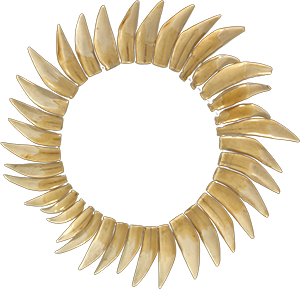Taíno
"Our Father" in Taíno:
Guakia baba (Our Father)
turey toca (is in sky)
guami-ke-ni (Lord of land and water)
guami-caraya-guey (Lord of moon and sun)
guariko (come to)
guakia (us)
tayno-ti (good,tall)
bo-matun; (big,generous)
busica (give to )
guakia (us)
aje-cazabi; (tubercles,bread)
juracan-na (bad spirit,no)
maboya-ua (ghost,no)
jukiyu-jan; (good spirit,yes)
Diosa (of God)
nabori daca ( servant am I)
Jan-jan catu (So be it)
[from Prehistoria de Puerto Rico, Dr. Cayetano Coll y Toste]
The Taínos came from South America and inhabited the Caribbean islands.Prior to them other groups had inhabited the islands; the Arcaicos and Araucos. The Arcaicos might have come from North America in the year 40 A.D. The second wave came from South America, near the Orinoco River and were the Araucos, around the year 370 A.D. Clashes between the Araucos and the Arcaicos might have ocurred in the area of the Virgin Islands and Puerto Rico. Between the VII and XI centuries the cultural phase known as the Pre-Taíno developed and later the Taínos flourished around the XIII century centralized in Puerto Rico.The third wave, the Caribs, came also from South America, around 1400 A.D.They extended from the island of Tobago to the island of Vieques and were fighting the Taínos in their efforts to go farther north at the time of the arrival of the Spaniards in 1493. At that time there were approximately 70-100 thousand indians in Boriken.The supreme cacique was Agueybana, residing in Guainía(now Guanica), in the Southwest.They called the island Borikén which meant "the great land of the valiant and noble Lord."
The taínos were bronze-colored, median in stature and had dark, flowing, coarse hair.They had dark,large eyes, slightly obliqued. Males and single women were naked while married women wore a cotton skirt caled a nagua.
The Taínos were divided in three social classes: the naborias or workers, the nitaínos or chiefs and noblemen and the bohiques or priests and medicine men.The cacique or guare was the chief of a yucayeque or village.The caciques were under one supreme chief who at the time of the discovery lived in the Southwest of the island.
The Taínos lived in a defined place and in groups.The central plaza of the yucayeques was the batey where the areytos and the ball games were performed. The caciques house or caney was in front of the caney and the bujius of the nitaínos and naborias were around. The caney was rectangular and larger while the bujíus were smaller and circular in shape.
The furniture were sparse- jamacas or hammocks, seats used by the chiefs, the dujos beds made of cane and called coy.
The taínos fished and hunted but their ocupation was mainly agriculture.They had plantations near to the villages, called conucos.
They cultivated the yuca, aje(batata), maisis(corn), maní(peanuts), tabaco, yayama(pineapple). Cotton was abundant. From the yuca they made a bread called casabe and by fermenting it they obtained an intoxicating brew, the uiku.
The Taínos believed in two spirits or Gods:Yukiyú(Yocahu), god of good and Juracán, god of evil.Yukiyú lived in a mountain in the northeast, (now El Yunque) and Juracán in Sibuqueira(Guadalupe), the land of its enemies, the Caribs. Juracán was responsible for storms, earthquakes and bad crops; Yocahu was an inmortal being with no beginning..
The main entertainments of the Taínos were the dance, music and ballgames. The ball games were played in the bateyes or in big ceremonial centers lined with monoliths such as the ones in Caguana(Utuado) and Tibes.They enjoyed dances(araguaco). To accompany their dances and areytos they had instruments such as maracas, güiro and flutes made from cane or bones.The areytos were important happenings in the life of the yucayeque. Through them the history of the village and its heroes was preserved.
The Taínos believed in in life after death and they buried their dead carefully placing food and water in the tombs so the spirit could use it in its journey.They would place in the tomb the cemi of the dead.The dead would be placed in a position with the knees at the level of the chest and the head in between.The caciques were buried with their possesions and treasures.
The number of Taíno words that persist in the vocabulary of the Puerto Rican people is extensive. Names of plants, trees and fruits include the maní, leren, ají, yuca, mamey, pajuil, pitajaya,cupey, tabonuco and ceiba. Names of fish,animals and birds include the mucaro, guaraguao, iguana, cobo, carey, jicotea, guabina, manati, buruquena and juey.Other objects and instruments include the güiro, bohío, batey, caney, hamaca, nasa, petate, coy, barbacoa, batea,, cabuya, casabe and canoa.
The Spaniards treated severely the indian population, forcing their work in mines and construction as well as in agriculture.They did not address the rights of that race that was the owner of their land and that so cordially had received them.Despite their eventual rebellion against the Spaniards the dissapearance of the Taínos turned out to be extreme and fast. Unused to slave labor conditions and exposed for the first time to European diseases for which they had no immunity, the Taíno population was rapidly decimated. By the late 1500's the Indian population as an ethnic group had disappeared although with extensive intermarriage with the Spanish and African populations the Taino became a permanent part of the island's racial heritage.

